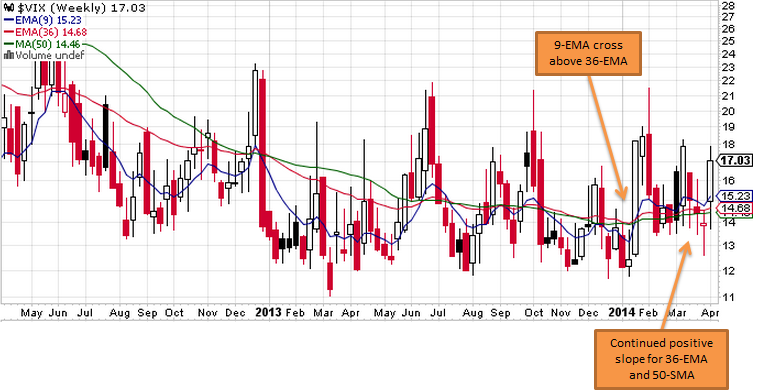Recap of the Week: 4/7/14 - 4/11/14
We saw a bit of weakness in the market last week with SPX down 3 of 5 days. VIX largely took the movement in stride, indicating that market participants continue to believe that dips will be bought, or at least, that this particular dip will be bought. We saw a signal to sell XIV / buy VXX on 4/10 as the VXX Bias and WRY MACD moved to positive on Thursday. The next day we saw VIX move as high as 17.85, before closing at 17.03 (+7%). This value of VIX is unusually low for a situation where SPX lost 3% over the course of 2 consecutive days (actual volatility for the week was 19.5). A VIX in the low/mid-20s would be more appropriate given historical comparisons (see this tweet after this Thursday's 2% sell off). No, the VIX is not "broken" here -- this just indicates that market participants do not see the need to buy puts to hedge their positions since the market has been in the pattern of quickly recovering from 5% dips in this new QE era.
Key Points & Outlook
- After a false break lower the week of 3/31 - 4/4, VIX opened up higher this week, retraced to last week's close by Wednesday, then continued up to close at a 4-week high. This kept the longer-term uptrend that started the week of 1/21/14 intact. VIX weekly chart, below, shows the 9-ema rise above the 36-ema and test it twice so far. Also note the positive slope of the 36-EMA and 50-SMA.
- (Remaining Key Points & Outlook are available to Members only. Please login to the Members' Forum to read the remainder of this article. If you're not yet a member you can join via the Subscribe page.)
.
.
Major Shifts In Volatility Structure
We've watched many significant developments in the world of VIX and VIX futures unfold over the past two months and have been discussing these events and their implications in our Members' Forum. Below I've jotted down a summary of points from our recent posts to provide a glimpse of these conversations.
We've watched many significant developments in the world of VIX and VIX futures unfold over the past two months and have been discussing these events and their implications in our Members' Forum. Below I've jotted down a summary of points from our recent posts to provide a glimpse of these conversations.
(You can get access to the Trading Volatility Forum as well as our VIX Futures data and analytics for just $40/month. See the Subscribe page for details.)
2/24/14 - Theme: Rising actual volatility (HV20 & HV60) in the S&P 500 is a sign of an aging market and signifies shifting market sentiment.
- VIX has shown a bit of reservation over the latest two week rally.
- Do not expect XIV to behave in the same way in 2014 as it did in 2013; Expect choppy trading and weaker bounces like what we are seeing now.
2/28/14 - Theme: Disappearance of the roll yield and a higher VIX base
- VIX has shown a bit of reservation over the latest two week rally.
- Do not expect XIV to behave in the same way in 2014 as it did in 2013; Expect choppy trading and weaker bounces like what we are seeing now.
2/28/14 - Theme: Disappearance of the roll yield and a higher VIX base
- VXX Bias has narrowed -- almost no negative roll yield in VXX since early Feb
- VIX making higher lows, forming base in 14s
- Near-term VIX futures not selling off this time around. Trending up since Feb 18.
- Investors not selling VIX futures this time around
3/18/14 - Theme: Market Indecision and VIX Doubt In The Latest S&P Rally
- VXX Bias remains thinly negative
- VIX indicating lingering uncertainty despite S&P rally
- Continued rise in level of actual volatility in SPX, specifically HV60
- VIX/VXV bouncing above & below 0.92 threshold, indicating a high level of indecision
- VIX/VXV bouncing above & below 0.92 threshold, indicating a high level of indecision
3/28/14
- Continued indecision with VIX range-bound
- Watch for development of more negative VXX Bias
- Watch for development of more negative VXX Bias
3/31/14
- Break of the VXX trendline indicates lower prices to come
4/3/14
- Weak market action in NDX and Russell 2000 prompts reduction in XIV position. Not a good time to aggressively short
4/4/14
- No show of fear yet despite selling in SPX. Watch out for further downside on Monday (4/7),
4/10/14
- Change in VXX Bias and WRY MACD signal a move higher in VXX.









